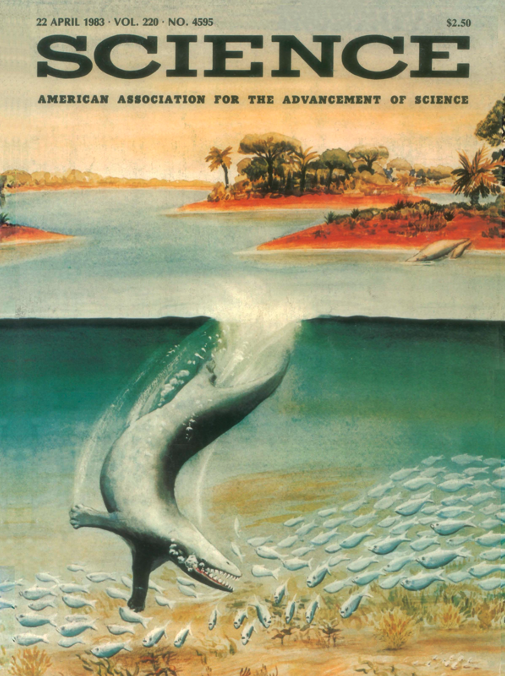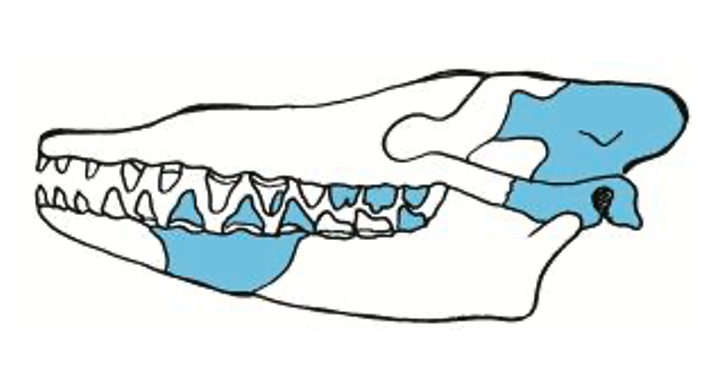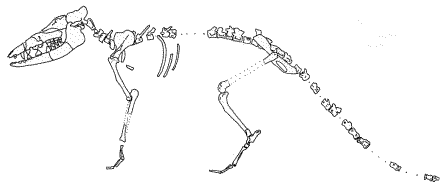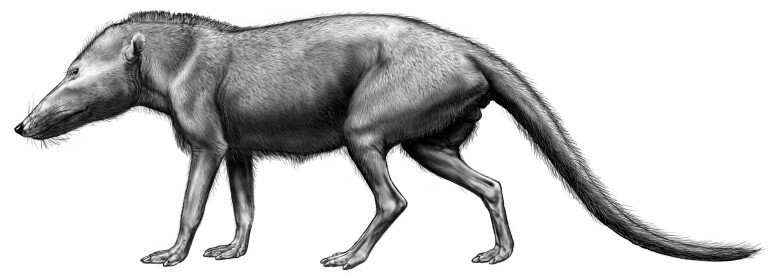The Tale of the Walking Whale
Evolutionists’ “Best Example” of a Missing Link Fails
For over 100 years now, a variety of fossil skulls and bones described as “missing links” between various creatures have been displayed in museums and featured in textbooks in support of the story of evolution.
And why are they referred to as missing links? Because evolutionists don’t seem to find enough fossils to fill all the spaces in between the various kinds of creatures we know about (i.e., they’re missing).
And while some evolutionists balk at the term “missing link” as being somewhat unrefined, the average person usually gets what it’s referring to. Even popular articles from popular sources like the Britannica website1 define them (in this case, specifically in relation to supposed human evolution) in this way.
Missing link—hypothetical extinct creature halfway in the evolutionary line between modern human beings and their anthropoid progenitors.
However, regarding the surety of their supposed existence despite the lack of hard evidence, it goes on to say,
These ancestors have yet to be identified, but ape-hominid divergence may have occurred 6 to 10 million years ago. [emphasis mine]
Again, “yet to be identified” equates to “still missing.”
Looking for Links
Now, evolutionists believe the fossil record is like looking at the imagined long history of life on earth. So, they continue to look within it for evidence showing one type of creature having gradually turned into another. And not just between supposed ape-like creatures and people but among all of the creatures that have ever been.
So, for example, as the story of evolution states that a dinosaur-type reptile supposedly evolved into birds over millions of years, then we should expect to see many, many fossils of creatures that look less and less like reptiles that become more and more like birds in the fossil record.
And if they find something they think fits the bill, so to speak, then these are referred to as transitional fossils. And when you think about it, there should be way more transitional fossils than of either lizards or birds, for example, because of the many small evolutionary steps or “links” between the stages of their supposed evolution.
It’s Always Been a Problem
Many are unaware that Charles Darwin himself considered the weakest link in his entire naturalistic hypothesis to be the lack of fossil evidence for these missing intermediate links—a problem which has never been overcome.
Many are unaware that Charles Darwin himself considered the weakest link in his entire naturalistic hypothesis to be the lack of fossil evidence for these missing intermediate links—a problem which has never been overcome. Darwin asked a question then made an admission and a statement all in one quote that perfectly sums up the problem .
Why then is not every geological formation and every stratum full of such intermediate links? Geology assuredly does not reveal any such finely-graduated organic chain; and this, perhaps, is the most obvious and serious objection which can be urged against the theory.2
Unfortunately for evolutionists, more than 150 years later they only have a few handfuls of highly disputed (even among their own evolutionary community) “transitional” forms to point to. And this lack of evidence for them caused even the famous evolutionist Steven J. Gould to admit,
The absence of fossil evidence for intermediary stages between major transitions in organic design, indeed our inability, even in our imagination, to construct functional intermediates in many cases, has been a persistent and nagging problem for gradualistic accounts of evolution.3
Gould openly admitted that not only do we not see the many expected (by evolutionists), supposed missing links, but that it would be hard to figure out what a half lizard/bird (for example) would even look like, let alone how it would possibly survive!
Which is very astute when you think about it. I mean, what exactly would a “libard” look like? How would it get around (seeing as how lizards and birds have a very different type of locomotion)? How would it breathe (as the two creatures have very different breathing systems)?
How would birds have developed such specialized genetic instructions for things like hollow bones, feathers, preening glands, and flight navigation systems that allow them to migrate for thousands of kilometres and fly in flocks without colliding with each other? Because lizards don’t have any of those features.
Gould actually thought the lack of transitional fossil issue was so problematic that he came up with a new story of evolution called “punctuated equilibrium.” This story basically stated that instead of evolution happening slowly over millions of years (i.e., “gradualistic”), each episode must have happened very quickly instead, with millions of years of very little or no change in between these rapid spurts.
He suggested it happened so quickly, in fact, that (very conveniently), virtually no fossils of the in-between stages of the alleged new creatures would be expected to be left behind. However, after he passed away, his influence waned, and the evolutionary community seemed to slip back into the former idea of the slow modification over deep time model, primarily.
So, having said all this, providing evidence of supposed missing links and transitional fossils is kind of a big deal for evolutionists. So, what are some of the famous go-to transitional forms that evolutionists attempt to use to bolster their evolutionary story?
Well, former champions of “missing links” like the ever popular Archaeopteryx have waned considerably of late, what with the discovery of an admitted (by evolutionists) true bird which dates (according to evolutionists’ own methods) at 60 million years older than Archaeopteryx. Kids can’t be older than their parents. Which means if there were true birds before good old “Archae,” he obviously wasn’t the droid (i.e., “transitional creature” between dinosaurs and birds) they were looking for.
And we could point to the more recent and very popular Tiktaalik, whose stardom quickly rose several years ago as the perfect missing link candidate and then burnt out shortly thereafter as evolutionists admitted it too was overturned by new evidence.
So, what then might be put out there front and center as solid evidence of a transitional fossil candidate these days? Well, evolutionists will often claim that the solid evidence has indisputably proven that whales evolved from land animals, and this whole idea came originally from a specimen dubbed Pakicetus, meaning whale of Pakistan.
Pakicetus
Now, if a teacher randomly threw the name Pakicetus at a student who didn’t know about it and asked them to do a report on what it is, the average high schooler would likely hop online and look up some of the top results that would appear to prepare their work.
However, what they would find wouldn’t just be “the facts,” so to speak. It would be a mixture of facts, combined with interpretations of those facts, based on evolutionary presuppositions, all wrapped in some heavy storytelling. And what do I mean by that?
Well, let me read you a description (again from the Britannica website) describing this creature, and I’m going to modify it by omitting some comments first time round, and then, I’ll insert them back in the second time to demonstrate the obvious storytelling going on here despite the facts that have been found.
Pakicetus—extinct genus of early mammals known from fossils discovered in 48.5-million-year-old river delta deposits in present-day Pakistan. Pakicetus [was] discovered with functional legs. It has many features of terrestrial mammals, including an auditory system for hearing in air, a dentition not unlike that of its closest relatives, such as the mesonychids [extinct mammals similar in appearance to wolves], and functional feet capable of locomotion on land.
The body mass of Pakicetus was estimated at 45 kg (100 pounds), roughly the size of a wolf or large dog. The dentition of the animal indicates that it had a diet primarily of fish; however, its skeleton and skull suggest that it spent a considerable amount of time on land.
OK, so along with the artists rendition provided alongside the description I gave, the student would get a pretty clear understanding of what sort of creature this was. Namely, a land-dwelling, four-legged mammal roughly the size of a wolf that is depicted looking somewhat between a dog and a giant rat. Nowhere in the description would the idea of a whale pop into your mind based on the facts presented.
Now, this time I’m going to present the entry verbatim, and I want you to notice all the nuances in phrasing and the way they try to convince you (based on assumptions that we’ll explore further) to try to sound like this is evidence of a creature transitioning into a whale which I omitted the first time around.
Pakicetus—extinct genus of early cetacean mammals known from fossils discovered in 48.5-million-year-old river delta deposits in present-day Pakistan. Pakicetus is one of the earliest whales and the first cetacean discovered with functional legs. In addition, it still retained many other features of terrestrial mammals, including an auditory system that was better for hearing in air than in water, a dentition not unlike that of its closest terrestrial relatives, such as the mesonychids, and functional feet capable of locomotion on land.
The body mass of Pakicetus was estimated at 45 kg (100 pounds), roughly the size of a wolf or large dog. The dentition of the animal indicates that it had a diet primarily of fish; however, its skeleton and skull suggest that it spent a considerable amount of time on land.4
Where Did the Whale Come From?
Now, if this whole subject is new to you, you might be thinking where on earth would they get the idea that this hairy, four-legged, land wolf/rat creature was some kind of a whale with legs?
Why are they saying it is an “early whale” if it walked around on four legs? They say it likely ate fish, but so do bears, and they aren’t land whales. Surely, there must be something more to it than the facts they are presenting here? Well, let’s go through the history of this discovery and explore it in more detail.
In his 1983, Dr. Phil Gingerich, a whale paleontologist from the University of Michigan, had an article published in Science magazine purporting a monumental evolutionary discovery where he claimed his find, Pakicetus “is the oldest and most primitive whale yet discovered. . . . It is an important transitional form linking Paleocene carnivorous land mammals and later, more advanced marine whales.”5

Supposedly based on all the fossil evidence he’d found, the magazine cover featured a rather goofy-looking drawing depicting a half-land, half-sea creature diving into the water to hunt fish. And yet, how much physical evidence had he collected that would inspire such a depiction?

Well, the only bits of bone he’d collected were a few pieces of the skull (shown in blue in the diagram above). He had absolutely no fossil evidence below the head!6 Now think about this, if the drawing was supposedly based on the facts he had at the time, how could he possibly know what the diet of the creature supposedly was or know how to get an artist (if you could call them that) to draw the entire creature, complete with front legs and flipper-like feet?
And yet, despite not having a complete skeleton of the creature, a full 11 years later, Gingerich was still so taken with his own imagination that he was still declaring,
In time and in its morphology, Pakicetus is perfectly intermediate, a missing link between earlier land mammals and later, full-fledged whales.7
Now remember, there was nothing in the bits of skull he’d found that would definitively indicate this creature operated in water—no blowhole or nostril on the top of it, nothing indicating it had ears that were designed for use in aquatic environments, etc. And yet, he spoke this confidently about his discovery and had all this published in prestigious, peer-reviewed scientific journals!
However, by 2001, nearly 20 years after his initial announcement in Science magazine, almost the whole skeleton was finally uncovered.8 And what did it show?
Well, a technical paper in Nature unequivocally declared that the bones demonstrated Pakicetus was a land animal and “no more amphibious than a tapir” (which is a piglike creature)!9 The Encyclopedia of New Zealand website10 depicted the creature with muscle and skin in the following way, which is fairly similar to most depictions shown today.11


Now, let’s take a look at a whale for a moment and compare these two creatures.
Considering the incredible differences in size and morphology, how Gingerich could have made his claim that Pakicetus was a “perfect intermediate,” a missing link between land mammals and whales, when its current description is that of a wolflike animal about one to two meters long is frankly astonishing and a testimony to the amount of storytelling commonly involved in the so-called “science” of evolution.
And had the complete skeleton been uncovered and shown to the scientific community and the general public from the outset, claims of what are now commonly referred to as “terrestrial cetaceans” (literally, land whales) would almost surely have been metaphorically laughed out of town!
I mean, one can look up the dictionary definition of whale and find the following:
Whale, noun: a very large marine mammal with a streamlined hairless body, a horizontal tail fin, and a blowhole on top of the head for breathing.12
And yet there was never an indication of any of these features (marine dwelling, hairless, tail fin, blowhole for breathing etc.) found from the earliest days in 1983 all the way to 2001 while Pakicetus was being researched.
The Tipping Point Was Reached
However, in school rooms, colleges and universities, museums, zoos, or aquariums, as well as in textbooks, online articles, and peer reviewed journals today, such claims are greeted with serious nods of acceptance and thought of as scientifically legitimate.
Charts showing wolflike land animals whose feet morph into webbed and then flipper-like feet, which then gradually lose their hind limbs and grow fins and flukes while their nostrils shift from the front to the top of their heads are now seen as proof positive of the once missing links between land animals and whales!
And they are taught and illustrated using a lineage of supposed transitional creatures beginning with Pakicetus all the way to true whales we see today, which seems similar to how the old (and now totally debunked) horse evolution series found its way into many other publications and textbooks for over 150 years.
Evolutionists constantly need new “proofs” to prop up their worldview. So, while the horse evolution series was falling off the back end of the evolutionary evidence conveyor belt, the whale fossil series was just being assembled and placed at the front of it.
And evolutionists now show diagrams to students with all sorts of supposed intermediates between Pakicetus and true whales to make the evidence seem truly robust. And yet, just like Pakicetus, when closely examined, each and every one of these supposed missing links absolutely fail to qualify as true transitional forms upon inspection.
They fail just like the number one argument I hear over and over again from evolutionists that push this whale evolution nonsense fails. And that is, why do whales have vestigial (leftover) legs if they didn’t evolve from land animals? What use would hind legs have been to whales?
Well, while it’s true that modern whales are often described in evolutionary textbooks as having “vestigial hip bones,” which they say used to anchor legs (and this is often touted as proof of the whale evolution series), they never find actual legs in whales—vestigial or otherwise.
What they find is pelvic bones that perform a specific purpose. And a 2014 article in the journal Evolution13 confirmed that there is a perfectly designed and critical function involved in the need for whale’s pelvic bones after all—procreating. Without their pelvic bones, they’d all be dead! Which means there’s no evidence they are “vestigial” in any true sense at all.
Hurling the Whale?
I hope this brief dive into just one of the many evolutionary arguments out there has been beneficial in showing you just how weak most of them truly are when stripped down.
Christians should beware of the illegitimate debate tactic known as “elephant hurling” (perhaps in this case we should call it “whale hurling”), often heard when evolutionists declare statements like, “The evidence for evolution is so overwhelmingly strong that I just can’t understand how any intelligent person doesn’t believe it!”
However, hurling the elephant is simply a bluff. And there’s a reason why circumstantial evidence in a courtroom is given little weight, and in a case where such circumstantial evidence is simply piled on top of another in an attempt to sound robust, it is typically deconstructed rather soundly by an experienced opponent. Because such evidence is usually strung together with much imaginative storytelling.
It’s a made-up story, just like the made-up story that says land animals turned into whales over millions of years.
And you’ll likely notice that I use the phrase “the story of evolution” when talking about the materialist’s origin account. And I do that very specifically—because that’s what it is. It’s a made-up story, just like the made-up story that says land animals turned into whales over millions of years.
And it’s not so much that I am surprised (although I am disappointed) when the world gets sucked into believing these things, it’s when I see brothers and sisters in Christ get caught up in accepting these stories that are in complete contradiction to the Word of God that I become grieved because I know where it can lead people. As the Apostle Paul warned Timothy, it can sometimes lead to their worst possible regret:
O Timothy, guard the deposit entrusted to you. Avoid the irreverent babble and contradictions of what is falsely called “knowledge,” for by professing it some have swerved from the faith. 1 Timothy 6:20–21
Footnotes
- Britannica, “Missing Link,” Encyclopedia Britannica, last updated November 22, 2016, https://www.britannica.com/science/missing-link.
- Charles Darwin, Origin of Species, 6th ed. (London: John Murray, 1902), 413.
- Stephen Jay Gould, “Is a New and General Theory of Evolution Emerging?” Paleobiology 6, no. 1 (January 1980): 127, https://doi.org/10.1017/S0094837300012549.
- Britannica, “Pakicetus,” Encyclopedia Britannica, last updated January 25, 2016, https://www.britannica.com/animal/pakicetus.
- Philip D. Gingerich, “Evidence for Evolution from the Vertebrate Fossil Record,” Journal of Geological Education 31, no. 2 (1983): 140–144, https://doi.org/10.5408/0022-1368-31.2.140.
- Dr. Terry Mortenson, “Fossil Evidence of Whale Evolution?” Aquatic Animals, Answers in Genesis, accessed October 5, 2023, https://answersingenesis.org/aquatic-animals/fossil-evidence-of-whale-evolution/.
- Philip D. Gingerich, “The Whales of Tethys,” Natural History 103, (April 1994): 86, Google Scholar.
- Mortenson, “Fossil Evidence of Whale.”
- Mortenson, “Fossil Evidence of Whale.”
- Te Ara, “Pakicetus, Whale and Dolphin Ancestor,” The Encyclopedia of New Zealand, last updated September 1, 2015, https://teara.govt.nz/en/diagram/4690/pakicetus-whale-and-dolphin-ancestor.
- Mortenson, “Fossil Evidence of Whale.”
- Google Dictionary, “Whale Meaning,” from Oxford Languages, accessed October 6, 2023, https://www.google.com/search?sca_esv=566347325&sxsrf=AM9HkKk0ex7xnjpG_jkBbuWuMnzH_8Vqcg:1695062173831&q=whale&si=ALGXSlZC_jbid1uaZGfc4a798NDv_3Re8lEoRHKzsatQQkASPY2OYnthZr2abOcoHc_lwnrVSo216uuj3YQ2SIxcO1wHD7uZIg%3D%3D&expnd=1&sa=X&ved=2ahUKEwik8_jV5rSBAxX9MjQIHf_9DUsQ2v4IegQIHRAw&biw=1563&bih=927&dpr=2.
- James P. Dines et al., “Sexual Selection Targets Cetacean Pelvic Bones,” Evolution 68, no. 11 (September 2014): 3296–3306, https://doi.org/10.1111/evo.12516.

Answers in Genesis is an apologetics ministry, dedicated to helping Christians defend their faith and proclaim the good news of Jesus Christ.
- Customer Service 800.778.3390
- Available Monday–Friday | 9 AM–5 PM ET
- © 2025 Answers in Genesis



